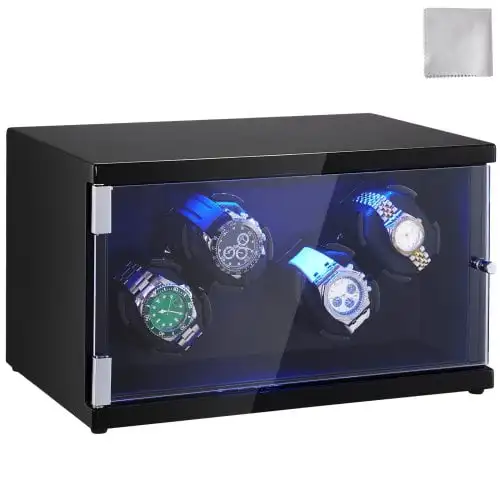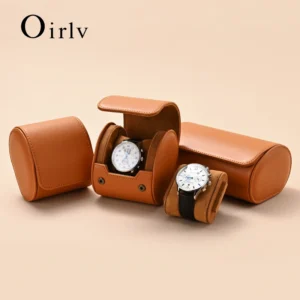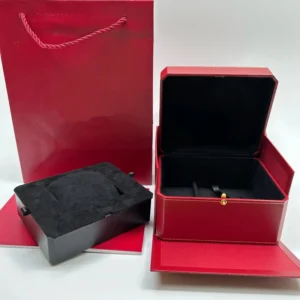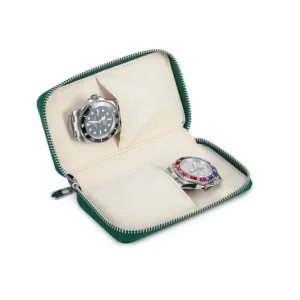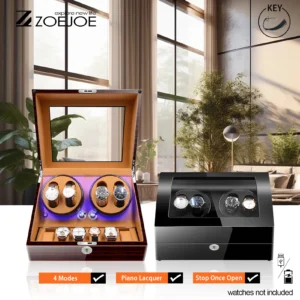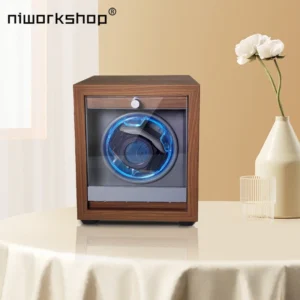What Are Turns Per Day (TPD) for a Watch Winder?
Turns Per Day, commonly abbreviated as TPD, represents the number of complete rotations a watch winder performs within a 24-hour period. This measurement is fundamental to the proper functioning of automatic watches, which rely on movement to maintain power and accurate timekeeping.
Automatic watches contain a self-winding mechanism featuring a semicircular metal weight called a rotor. When you move your wrist during normal daily activities, this rotor spins, winding the mainspring that stores energy for the watch. The stored energy, often referred to as power reserve, typically lasts between 40-72 hours depending on the watch model.
Watch winders serve as mechanical substitutes for human wrist movement, simulating the natural motion that keeps automatic watches running. The average person generates approximately 600-800 wrist rotations daily during normal activities, which is why most watch winders operate within a similar range.
Key aspects of TPD include:
• Direct correlation to how much energy is transferred to your watch’s mainspring
• Specific requirements that vary by watch brand and model
• Precision settings that affect long-term watch performance
When your automatic watch sits unworn, a properly configured watch winder programming settings prevent it from stopping, eliminating the need to reset the time, date, and other complications when you decide to wear it again.
Understanding TPD is essential for anyone who owns multiple timepieces or doesn’t wear their automatic watches daily. Our selection of quality automatic watch winders offers various TPD settings to accommodate different watch requirements.
Why Correct TPD Settings Are Essential for Your Automatic Watch
Setting the proper TPD for your watch winder isn’t just about keeping your timepiece running—it directly impacts the long-term health and performance of your valuable automatic watch.
Maintaining optimal power reserve is crucial for consistent timekeeping. When a watch operates within its ideal power range, the movement functions as designed, keeping accurate time. Insufficient winding leads to power reserve depletion, causing your watch to slow down and eventually stop. This means you’ll need to reset the time and other complications when you next wear it, which becomes particularly frustrating with calendar or moon phase functions.
Proper winding also ensures that lubricants remain evenly distributed throughout the movement. Automatic watches contain tiny components that require lubrication to reduce friction and wear. When a watch remains stationary for extended periods, these oils can congeal or pool in certain areas, potentially leading to increased friction when the watch resumes operation.
Key benefits of correct TPD settings include:
• Consistent timekeeping accuracy
• Even distribution of essential lubricants
• Reduced wear on winding components
• Extended service intervals
• Prevention of power reserve fluctuations
For vintage watches without slip clutch mechanisms, proper TPD settings are particularly important as these timepieces lack the protection against overwinding that modern watches have. Setting TPD too high for these watches could potentially damage the delicate internal components.
Understanding how to program watch winder setup correctly saves you both the inconvenience of resetting your watch and the potential expense of unnecessary servicing due to improper maintenance.
Understanding Winding Direction: CW, CCW, and Bidirectional
The direction in which a watch winder rotates is just as important as the number of turns it performs. Different watch movements are engineered to wind efficiently in specific directions, making this a crucial setting to understand.
There are three primary winding directions available on quality watch winders:
Clockwise (CW): When viewing the watch face-up, the rotation moves in the same direction as a clock’s hands. Some older watch movements and specific brands are designed to wind most efficiently in this direction.
Counter-Clockwise (CCW): The rotation moves opposite to a clock’s hands when viewing the watch face-up. Certain watch brands and movements are engineered to capture energy most effectively from this direction.
Bidirectional: The winder alternates between clockwise and counter-clockwise rotation. Most modern automatic watches use bidirectional winding systems, making this the most versatile and commonly used setting.
It’s important to note that winding direction is always referenced from the perspective of looking at the watch face, not the caseback. This distinction helps avoid confusion when setting up your winder.
Using an incorrect winding direction can result in inefficient energy transfer to the mainspring. While a watch set to the wrong direction might still receive some winding, it won’t be optimal and could lead to insufficient power reserve.
Many collectors are surprised to learn that winding direction relates directly to rotor design. Some rotors are engineered with a specific geometry that captures energy more efficiently when moving in a particular direction.
The ultimate guide to automatic watch winder settings provides detailed information on specific movement types and their directional requirements. For collectors with multiple watches, investing in versatile watch winders with adjustable direction settings ensures compatibility with various timepieces.
General TPD Range for Most Automatic Watches
While specific TPD requirements vary by brand and model, most automatic watches function optimally within a standard range of 650-950 turns per day. This range works for many watches due to similarities in mainspring design and power reserve requirements across the industry.
Several factors influence the ideal TPD setting for a particular watch:
• Age of the watch: Vintage timepieces often have different winding mechanisms than modern watches
• Movement type: In-house calibers vs. standard movements have varying winding efficiencies
• Power reserve duration: Watches with longer power reserves may require different winding patterns
• Mainspring design: The size and construction of the mainspring affects winding requirements
For general guidance, automatic watches typically fall into these TPD categories:
| TPD Category | TPD Range | Common Examples |
|---|---|---|
| Low | 650-750 | Most Rolex, Tudor, older Omega models |
| Medium | 750-850 | Seiko, TAG Heuer, modern Omega |
| High | 850-950+ | Some Breitling, Vacheron Constantin |
Some watches have requirements outside this standard range. For example, certain high-complexity movements may need up to 1,200 TPD or more, while some vintage pieces function best at lower settings around 500-600 TPD.
When in doubt about your specific timepiece, starting in the middle range (around 800 TPD) with bidirectional winding is generally safe for modern watches while you determine the optimal setting through observation.
Watch Winder TPD Settings Database by Brand and Model
Finding the correct TPD and winding direction for your specific watch is crucial for optimal maintenance. Below is a comprehensive reference table organized by brand and model to help you properly configure your watch winder.
This database covers major luxury and mid-tier brands with automatic movements. Keep in mind that even within the same brand, different movement calibers may have varying requirements. Always refer to the specific caliber number when available, as this provides the most accurate guidance.
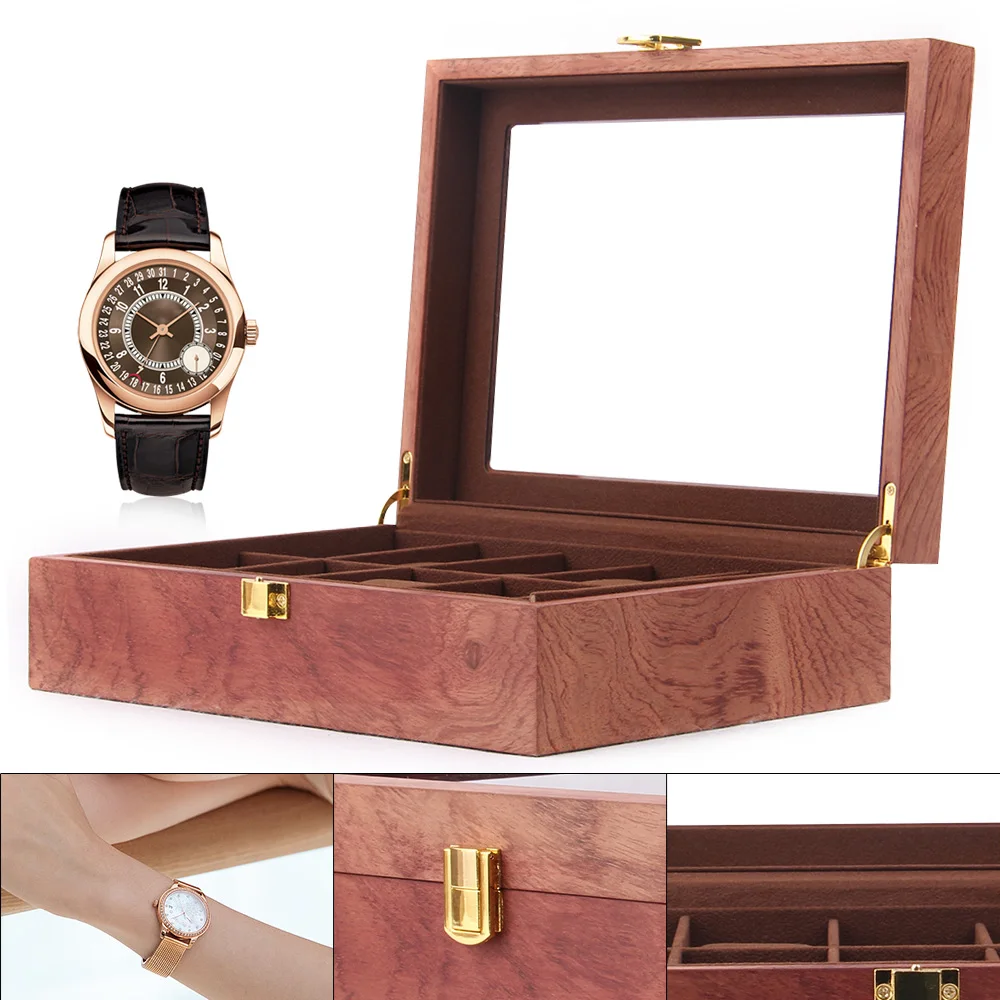
| Watch Brand | Watch Model/Caliber | TPD Setting | Winding Direction |
|---|---|---|---|
| Audemars Piguet | Royal Oak (3120/4302) | 800 | Bidirectional |
| Baume & Mercier | Clifton (Caliber BM12) | 800 | Bidirectional |
| Bell & Ross | BR 05 (Sellita SW300) | 800 | Bidirectional |
| Blancpain | Fifty Fathoms | 800 | Bidirectional |
| Breitling | Caliber B01/B04 | 650 | Bidirectional |
| Breitling | Caliber B20 | 750 | Bidirectional |
| Cartier | Caliber 1847 MC | 800 | Bidirectional |
| Grand Seiko | 9S Series | 800 | Bidirectional |
| IWC | Caliber 52000 Series | 900 | Bidirectional |
| Jaeger-LeCoultre | Caliber 899 | 800 | Bidirectional |
| Longines | L888 | 650 | Bidirectional |
| Omega | Caliber 8500/8900 | 800 | Bidirectional |
| Omega | Caliber 3330 | 750 | Bidirectional |
| Oris | Caliber 400 | 650 | Bidirectional |
| Panerai | P.9000 Series | 800 | Bidirectional |
| Patek Philippe | Caliber 324 S C | 800 | Bidirectional |
| Rolex | Caliber 3135/3235 | 650 | Bidirectional |
| Seiko | 6R15/6R35 | 800 | Bidirectional |
| TAG Heuer | Caliber 5/Caliber 16 | 800 | Bidirectional |
| Tudor | MT56xx Series | 650 | Bidirectional |
| Vacheron Constantin | Caliber 5100 | 800 | Bidirectional |
| Zenith | El Primero | 800 | Bidirectional |
Understanding the specific watch winder settings by movement type helps ensure you’re providing the optimal care for your timepiece collection. For watches not listed here, refer to the next section for methods to determine your watch’s ideal settings.
How to Determine the Correct TPD for Your Specific Watch
If your specific watch model isn’t listed in the database above, don’t worry. There are several reliable methods to determine the optimal TPD settings for your automatic timepiece:
Check official documentation
Start with your watch’s manual, which often includes recommended winder settings. Many manufacturers now include this information in the specifications section.Visit manufacturer websites
Many luxury watch brands maintain technical sections on their websites with winding specifications for their movements. Look for service or product support pages.Contact authorized dealers
Authorized dealers typically have access to technical databases with winding specifications for the brands they carry.Systematic testing approach
When official information isn’t available, follow this testing process:
- Begin with 800 TPD bidirectional (a safe middle ground for most watches)
- Set your watch to the correct time and place it on the winder for 48 hours
- Check if the watch maintains accurate time and has sufficient power reserve
- If the watch stops or loses significant time, increase the TPD by 100
- If the watch runs properly, you can try decreasing the TPD by 100 to find the minimum effective setting
- Allow 24-48 hours between adjustments for accurate assessment
Signs that your TPD setting is too low include the watch stopping overnight or showing significant time loss. While modern watches generally can’t be overwound due to safety mechanisms, unnecessarily high TPD settings can cause additional wear on components.
You can check if a watch is fully wound by gently rotating the crown in the winding position (usually clockwise). If you feel increased resistance, the mainspring is likely fully wound.
For comprehensive guidance on establishing the best automatic watch winder settings for your collection, monitor your watches over several weeks to ensure consistent performance with your chosen settings.
Can a Watch Winder Damage Your Automatic Watch?
One of the most common concerns about watch winders is whether they can potentially harm automatic watches through overwinding. The good news is that for most modern automatic watches, this fear is largely unfounded.
Modern automatic watches are equipped with a slip-clutch or bridle mechanism, ingeniously designed to prevent overwinding. When the mainspring reaches full tension, this safety feature disengages the winding system, allowing the rotor to spin without adding additional tension to the already-full mainspring.
However, there are some important considerations:
For modern watches (post-1960s):
The risk of damage from a properly functioning watch winder is minimal. Even if the TPD setting is higher than necessary, the slip-clutch mechanism prevents the mainspring from being wound beyond capacity.
For vintage watches:
Older timepieces may lack these protective mechanisms, making them potentially vulnerable to overwinding damage. If you own vintage automatics, it’s advisable to use conservative TPD settings and consider periodic rest periods.
The real concern isn’t overwinding but rather excessive mechanical action. Continuous winding beyond what’s necessary for maintaining power reserve can lead to accelerated wear on moving parts over time. This is why finding the correct TPD—the minimum required to keep your watch powered—is important for long-term care.
Many watchmakers recommend intermittent winding schedules (with rest periods) rather than continuous 24/7 rotation. This approach mimics natural wear patterns more closely and can reduce unnecessary mechanical action.
For specific issues related to your winder or watch performance, consulting our guide on troubleshooting common watch winder problems can help identify and resolve potential concerns.
Choosing and Using a Watch Winder Effectively
Selecting the right watch winder and using it properly ensures your timepieces remain in optimal condition while not in use. Here are the essential features to look for when choosing a quality watch winder:
Critical Features:
• Adjustable TPD settings with range from at least 650-1000 turns per day
• Multiple direction settings (clockwise, counter-clockwise, and bidirectional)
• Quiet motor operation, especially important for bedroom placement
• Properly sized and adjustable cushions that fit various watch case dimensions
• Programmable start/stop cycles that mimic natural wearing patterns
Best Practices for Watch Winder Use:
When positioning your watch on the winder, ensure it fits snugly on the cushion without being too tight or too loose. The watch should remain stable during rotation without shifting position.
For collectors with multiple watches, consider implementing a rotation schedule. This approach not only extends the life of your winder but also ensures all your timepieces receive proper maintenance even if you have more watches than winder positions.
Environmental factors significantly impact both your watches and winder. Place your winder away from direct sunlight, magnetic fields, and areas with temperature fluctuations. The ideal environment maintains a relatively consistent temperature (65-75°F) and moderate humidity (40-60%).
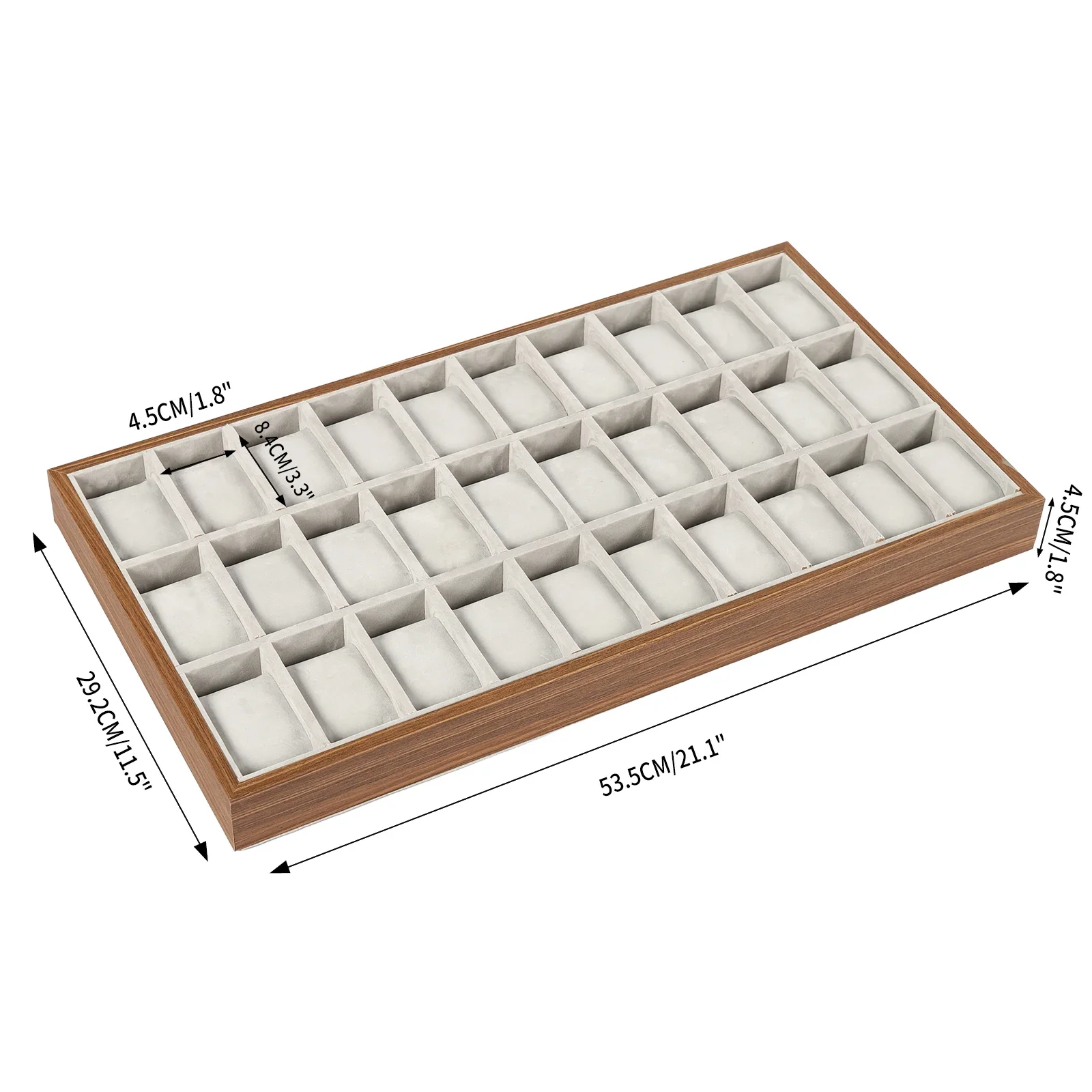
For those seeking premium options with advanced features, luxury watch winders offer sophisticated programming capabilities and superior construction quality that complement fine timepieces.
Single Watch Travel Case, Watch and Jewelry Box, Watch Roll Travel Case
Price range: $93.44 through $140.65 Select options This product has multiple variants. The options may be chosen on the product pageAutomatic Watch Winder, Luxury Watch Winder, Single Watch Box
$307.39 Select options This product has multiple variants. The options may be chosen on the product pageLuxury Watch Boxes, Luxury Watch Travel Case
Price range: $200.33 through $224.57 Select options This product has multiple variants. The options may be chosen on the product pageLeather Watch Travel Case, Men's Watch Travel Case, Watch Roll Travel Case
Price range: $91.37 through $92.63 Select options This product has multiple variants. The options may be chosen on the product page4 Watch Winder, 6 Watch Box, Automatic Watch Winder
$512.31 Select options This product has multiple variants. The options may be chosen on the product pageAutomatic Watch Winder, Single Watch Winder, Wooden Watch Holder
$201.76 Select options This product has multiple variants. The options may be chosen on the product page
Multiple Watches on a Single Winder: Managing Different TPD Requirements
Managing a collection of watches with varying TPD requirements presents a common challenge for enthusiasts. When your timepieces have different winding needs but need to share the same winder, strategic approaches can help maintain all your watches effectively.
For collectors with watches requiring different settings, consider these practical strategies:
Group similar watches: Organize your collection by TPD requirements, grouping watches with similar needs. For example, pair watches that function well at 650-750 TPD together, separate from those requiring higher settings.
Prioritize by wearing frequency: Watches worn less frequently should receive priority for winder space, as regularly worn timepieces naturally receive winding through daily movement.
Use compromise settings for similar watches: If you have watches with close but not identical TPD requirements (for example, one at 750 and another at 800), the higher setting will generally work adequately for both.
Create a rotation schedule: For collections larger than available winder positions, establish a weekly rotation system. For example, with 8 watches and a 4-position winder, switch which watches are on the winder every 3-4 days.
Many collectors find that a programmable winder with individual module settings works best for diverse collections. These units allow different TPD and direction settings for each watch position, though they typically command higher prices.
In situations where compromise is necessary, most modern watches function adequately at 800 TPD with bidirectional winding, even if their optimal setting differs slightly. This “universal setting” approach works reasonably well for short periods, though it’s not ideal for long-term storage.
Understanding the specifics of watch winder compatibility helps ensure that your entire collection receives appropriate care, regardless of the diversity of movement types.
Frequently Asked Questions About Watch Winders and TPD
How long should I keep my watch on a winder each day?
Most watch winders run intermittently rather than continuously, typically operating for 6-12 hours per day with rest periods. This pattern more naturally mimics actual wear while still maintaining sufficient power reserve. Many quality winders have programmable cycles that distribute the total TPD across the entire day.
Do all automatic watches need winders?
No. Watches worn daily generally don’t need winders as they receive sufficient movement through normal wear. Winders are most beneficial for watches worn in rotation, especially those with complicated features like perpetual calendars that are tedious to reset after stopping.
What happens if I use slightly incorrect TPD settings?
Using a slightly higher TPD than recommended typically causes no immediate issues in modern watches due to their slip-clutch mechanisms, though it may cause unnecessary wear over time. Settings that are too low may result in insufficient winding, causing the watch to stop or lose accuracy.
How do I know if my watch is fully wound on a winder?
A fully wound automatic watch should run for its entire specified power reserve when removed from the winder. For example, if your watch has a 42-hour power reserve, it should run for approximately 42 hours after being removed from the winder if it was properly wound.
Should I use a winder for watches I wear frequently?
Watches worn several times per week generally don’t need winders. The natural motion from wearing them provides sufficient winding, and the brief rest periods between wearings are actually beneficial for the movement’s longevity.
Can I store watches long-term on winders?
For extended storage (months or years), it’s generally better to let automatic watches rest rather than keeping them on winders continuously. Long-term storage is best handled by periodic manual winding (once every 3-4 weeks) to redistribute lubricants without causing unnecessary wear.
Watch Winding When Traveling: TPD Considerations
Maintaining your automatic watches while traveling presents unique challenges, especially when your normal winding routine is disrupted. Here are practical approaches to keep your timepieces running smoothly on the go:
For short trips lasting 2-3 days, most automatic watches with standard power reserves (40-70 hours) will continue running without intervention if fully wound before departure. Simply wearing your watch during travel will usually provide sufficient winding.
For longer journeys or when carrying multiple watches, consider these options:
Manual winding protocol: For watches not being worn, a simple manual winding routine can maintain power. Gently wind the crown 30-40 times every 2-3 days, ideally at the same time each day for consistency.
Portable travel winders: Compact travel winders are available for serious collectors, though they typically offer fewer setting options than home units. These portable solutions are ideal for trips lasting more than a week where maintaining complex watches like perpetual calendars is important.
Watch rotation strategy: If traveling with multiple watches but limited or no winding capabilities, establish a wear rotation. Alternating between watches every other day helps ensure each receives some winding through natural movement.
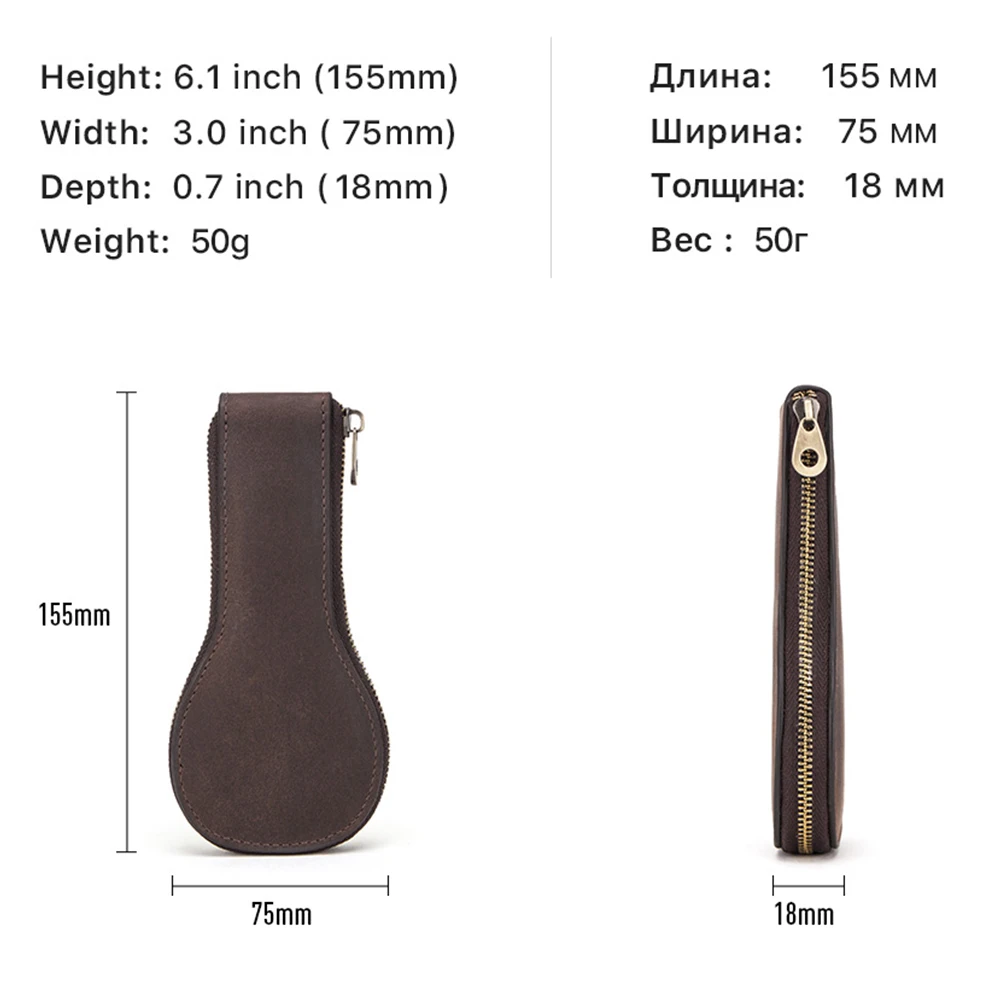
When traveling, proper protection for your watch becomes equally important as winding considerations. Quality watch travel cases provide essential protection from impacts, moisture, and other potential hazards while accommodating your timepieces securely.
For unworn watches during travel, storing them dial-up or crown-up positions generally helps minimize positional errors and rate variations while the movement is running.
Beyond TPD: Other Watch Winder Features Worth Considering
While correct TPD settings form the foundation of proper watch winding, modern winders offer additional features that enhance both functionality and the overall experience of watch ownership.
Programmable rest periods simulate natural wearing patterns more accurately than continuous rotation. These intervals of activity and rest better replicate how a watch would be worn on the wrist, potentially extending the life of both the watch and the winder motor.
Storage compartments for non-winding watches provide convenient organization for your entire collection. Many premium winders include drawers or display areas for watches not currently in the rotation cycle, creating a comprehensive storage solution.
Display features transform winders from purely functional tools into showcase pieces. LED lighting, rotation viewing windows, and glass covers allow you to appreciate your timepieces even while they’re being wound. These features are particularly appealing for watches with exhibition casebacks or intricate dial work.
Security options become increasingly important as collection value grows. Features like lockable cases, tamper-evident seals, and even integrated safes provide peace of mind for valuable collections, especially in shared living spaces or during extended absences.
Advanced power options enhance reliability and placement flexibility. Battery backup systems ensure continued operation during power outages, while DC adapters reduce electromagnetic interference that could potentially affect sensitive watch movements.
Understanding the optimal rotation speed for watch winders complements your knowledge of TPD settings, as the actual rotation speed (not just the total daily count) can impact both winding efficiency and watch performance.
When selecting a winder, prioritize essential functions like adjustable TPD settings and direction control first, then consider which additional features truly enhance your specific collection needs and display preferences.

